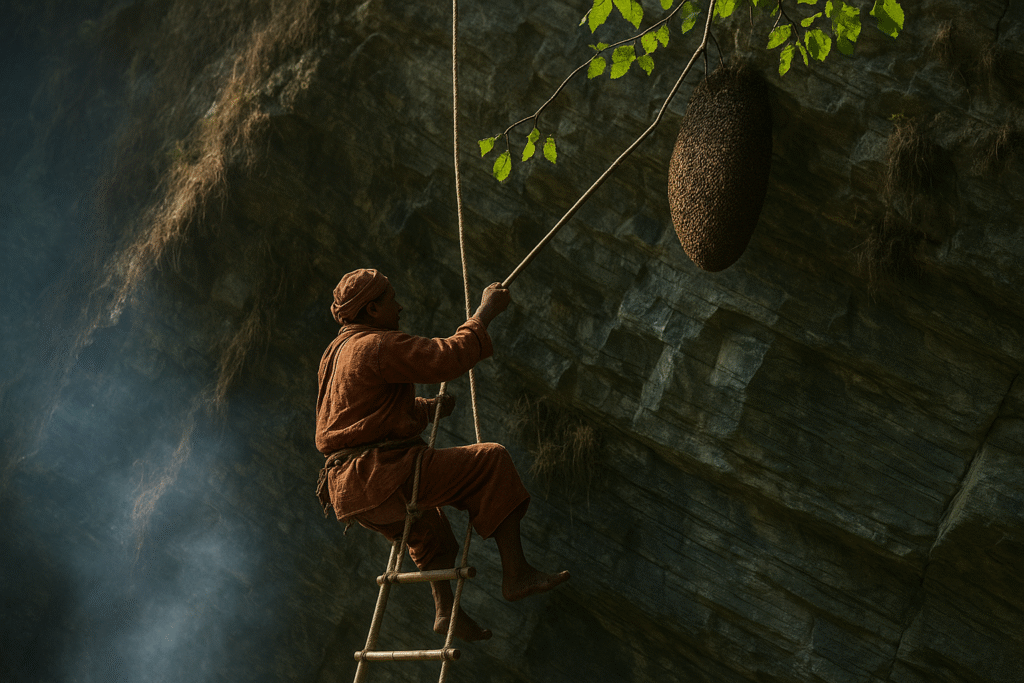Introduction: The Allure and Risk of Mad Honey Hunting
Deep in the rugged mountains of Nepal, a centuries-old tradition continues: Mad Honey Hunting.
Men dangle precariously from cliff faces, risking their lives to collect “mad honey”, a rare, intoxicating nectar. This honey, produced by Himalayan giant bees (Apis dorsata laboriosa), is famous for its unique psychoactive effects — and its dangers.
Today in 2025, this ancient practice is not just surviving — it’s thriving, despite the risks involved.
In this blog, we’ll explore the dangerous culture of mad honey hunting, why it captivates the world, and what it teaches us about resilience, tradition, and survival.
🌸 What is Mad Honey?
- Mad honey comes from the nectar of rhododendron flowers found in the Himalayan regions.
- It contains grayanotoxins, which affect the human nervous system.
- A small amount can cause euphoria, dizziness, and hallucinations.
- A larger dose can lead to nausea, seizures, or even death.
🐝 Why is Mad Honey Called “Mad”?
- The term “mad” refers to the intoxicating effects the honey induces.
- Historically used for rituals, healing practices, and even warfare (yes, enemies were poisoned with it!).
- Consumed for recreational highs and traditional medicine.
🏔 Where is Mad Honey Found?
- Remote Himalayan cliffs (Nepal, Bhutan, and parts of northern India).
- Elevations between 2,500–3,000 meters.
- Steep, rocky, dangerous terrains inhabited by giant bees.
🛡️ How Dangerous is Mad Honey Hunting?

Not So VERY dangerous but there are still some challenges.
- Climbing cliffs without modern safety equipment.
- Bee attacks while hanging hundreds of meters above the ground.
- Weather unpredictability (strong winds, rains).
- Physical exhaustion.
- Wild animal encounters (bears, snakes).
Every year, hunters risk their lives, and unfortunately, deaths are not uncommon.
🧓 The Traditional Process of Mad Honey Harvesting
- Prayer Rituals before starting the hunt.
- Lighting fires at the base of cliffs to smoke the bees out.
- Using bamboo ladders and handmade ropes.
- Hand-carving the honeycomb pieces.
- Carrying heavy loads of combs back home manually.
🧠 Fun Fact: Some hunters consider it a rite of passage into manhood.
🌿 Why Do They Still Risk It in 2025?
- Economic Value: One kilogram of mad honey can sell for $500–$600 or more in the black market.
- Cultural Identity: It’s tied to ancestral heritage and community pride.
- Medicinal Beliefs: Locals believe mad honey cures:
- Hypertension
- Arthritis
- Sexual dysfunction
- Gastrointestinal disorders
- Global Demand: Increased curiosity from tourists and natural medicine enthusiasts.
📈 How Mad Honey Gained Global Popularity ?
- Featured in documentaries (e.g., National Geographic).
- TikTok and Instagram trends showcasing “trips” after consuming it.
- Mad honey shops online (always research before buying!).
- Growing interest in psychedelic substances for wellness.
❌ Risks of Consuming Mad Honey
- Mild to moderate symptoms:
- Sweating
- Dizziness
- Blurred vision
- Nausea
- Severe symptoms:
- Bradycardia (slow heart rate)
- Paralysis
- Loss of consciousness
- Death in rare, extreme cases
🧠 Traditional Beliefs vs Modern Science
| Traditional Beliefs | Scientific Reality |
|---|---|
| Boosts vitality | Limited clinical research |
| Acts as natural aphrodisiac | No formal studies confirming it |
| Treats diabetes and hypertension | May regulate blood pressure slightly |
| Detoxifies body | Overdose causes toxicity |
🌏 Sustainable Mad Honey Hunting: Is It Possible?
- Bee population decline is real.
- Overharvesting threatens the delicate ecosystem.
- Some communities are moving towards ethical harvesting:
- Leave parts of the comb untouched.
- Rotate hunting spots.
- Limit the number of hunts per season.
📚 Best Places to Experience Mad Honey Culture (Safely)
- Ghalegaun, Nepal 🏔️
- Lamjung District 🐝
- Annapurna Circuit Villages 🚶
- Tamang Heritage Trail 🚴
🧡 Conclusion: Preserving a Dangerous Art
Mad honey hunting is not just a wild, dangerous job — it’s an ancient art form teetering between survival, tradition, and modernity.
As 2025 unfolds, responsible tourism and sustainable harvesting practices could be the keys to preserving this rare Himalayan culture — before it, like many others, disappears forever.
If you ever decide to try mad honey, respect the hunters, their courage, and the mountains that protect this sweet, dangerous gift.